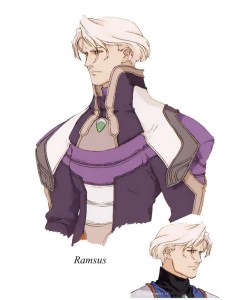Elly Van Houton

Elly Van Houton is the most important woman in the Xenogears videogame universe. She just doesn’t know it yet.
Elly is introduced as a soldier of the Solarian Empire. A rising star in the legendary Jugend military school, her elemental affinity is second to none. Raised in the belief that the Solarian people are, by divine right, the natural overlords of the surface dwelling Lambs, Elly is completely unprepared for her first meeting with protagonist Fei Fong Wong. Realizing that they have more in common than Solarian dogma would admit, Elly begins a long, reluctant conversion to the side of good.
But it turns out this is nothing she’s done before. Elly is the latest reincarnation of the Antitype, a being born from the god-like entity Wave Existence ten thousand years prior to the Xenogears story. Created to be the companion of Abel – Fei’s first incarnation – Elly has been at Fei’s side countless times throughout history. The reasons behind her creation: to help Fei make contact with the Wave Existence, thus giving him the power to destroy the Zohar Engine and free the Existence captured within it. Unfortunately, she has little success in this regard, often dying before she can complete her mission.
Elly’s willingness to help others is a constant theme throughout her incarnations. Five hundred years before the game’s story, Elly is Mother Sophia, the figure-head of the Nisan religion. Her presence is a calm beacon during the Shevat/Solarian war, drawing people together in the hopes of a better future. She even calmed the heart of Krelian, a man once governed by cynicism and bitterness. Sophia gave him a purpose outside battle and a love for science that would be present throughout his life. Unfortunately her death triggered Krelian’s obsession to create a God and the subsequent machinations throughout the game. Later on – most likely an echo of Sophia’s generosity – Elly becomes a similar symbol to the people suffering by Solarian cruelty.
There are thematic tragedies common to all her incarnations. She often dies before Fei; her last words are telling him to live. A popular argument is that Sophia’s death when Lacan – Fei’s incarnation of that time – made contact with the Existence was a crucial factor in his transformation into the uber-powerful Grahf and the global destruction that followed.
Elly Van Houton was just another Solarian soldier, committed to the Solarian dogma without question. Yet bit by bit she challenges the unnecessary cruelty of her Solarian superiors. Confronted with the mass genocide of the earthbound Kislev Empire, Elly finally takes action and nearly sacrifices herself so that more Kislev people can evacuate. Her love gives Fei the strength to resist his sadistic split personality Id, as well as giving him a place and person to return to after the necessary war effort. Few women can do so much good in one lifetime, never mind ten thousand years’ worth. It’s what makes her an incredible character.











